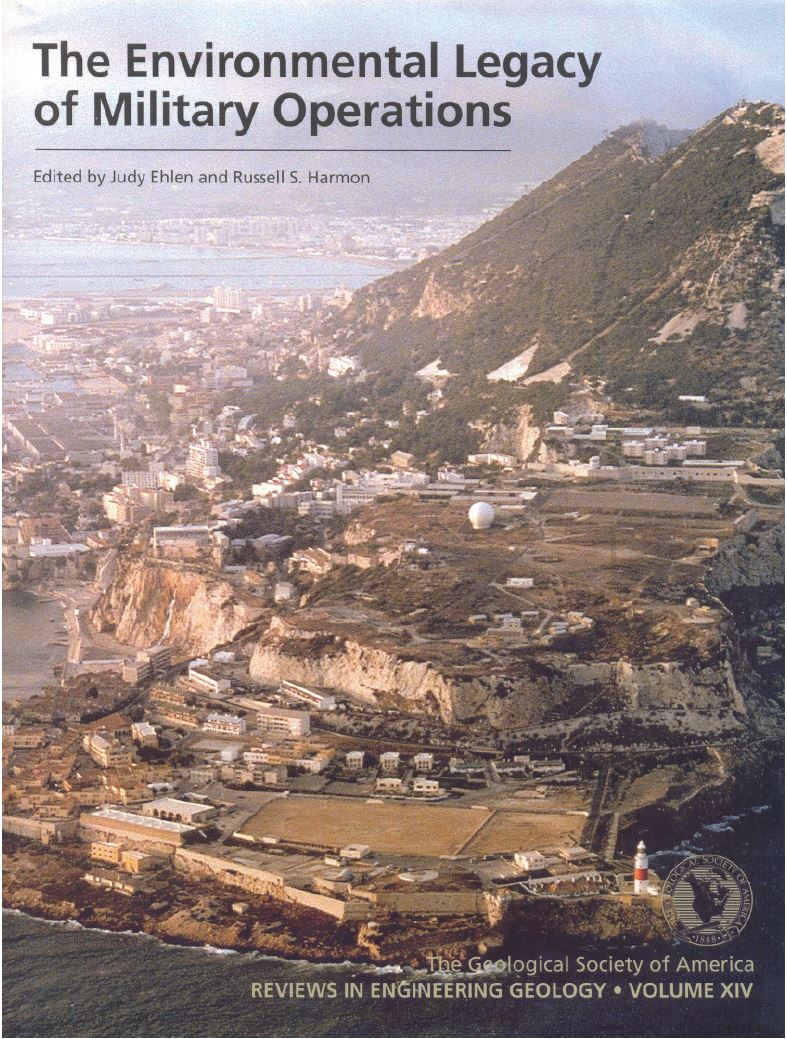Toronto, Canada, 1998
(Conference summary reproduced with permission; original text published in: Häusler, H. 2009. Report on National and International Military Geo-Conferences held from 1994 to 2007, MILGEO, Nr. 30E, Austrian Ministry of Defence and Sports).
In 1998 a half-day symposium on “The Environmental Legacy of Military Operations” was organised by the Geological Society of America, this time in Toronto, Canada. As for the proceedings of the fi rst conference in Seattle 1994, the Geological Society of America again published the contributions of the Toronto Conference. The two military geologists, Judy Ehlen, at that time in the U.S. Army Engineer Research and Development Centre (Alexandria, Virginia), together with Russell S. Harmon, U.S. Army Research Office (North Carolina) edited volume XIV of the “Reviews in Engineering Geology”. Twenty-six authors contributed fourteen papers in this volume, beside the introduction to the proceedings nine papers on military geology and four on military geography (EHLEN & HARMON, 1998). Their contributions are listed in Table 1.
Table 1 – Papers
| Author | Title | Subject |
|---|---|---|
| ALBERTSON | Sustainability of military lands: Historic erosion trends at Ford Leonard Wood, Missouri | Environmental change |
| BLAKE | Geoenvironmental factors in the regeneration of military airfields in Great Britain | WWII, geology, environmental change |
| CAMERON | Battlefield terrain and engineering geology in the eastern Chorwon Valley, central Korean Peninsula |
Geology, engineering geology |
| DUNBAR, WAKELEY, MILLER & SWARTZEL | Geology without borders: A conceptual model for Aberdeen proving ground |
Geology, environmental change |
| EHLEN | Predicting fracture properties in weathered granite in denied areas | Geology |
| GATTO, HALVORSON & McCOOL | Freeze-thaw-induced geomorphic and soil changes in vehicle ruts and natural rills | Trafficability, environmental change |
| GUTH | Quantifying terrain fabric in digital elevation models | Topography; DEM |
| HATHEWAY | Introduction | Geology |
| ISAACSON,HURST, MILLER & ALBERTSON | Unsurfaced road investigation and management plan | Trafficability, environmental change |
| JACOBI, EASTLER & XU | Methodology for remote characterization of fracture systems in bedrock of enemy underground facilities | Geology, Remote Sensing |
| NATHANAIL | Terrain evaluation for peacekeeping with examples from Bosnia Herzegovina |
Geology |
| NICHOLS & BIERMAN | Fifty-four years of ephemeral channel response to two years of intense World War II military activity |
WWII, Environmental change |
| PATRICK & BOYD | Wetlands and erosion studies in support of military training |
Erosion |
| ROSE | Military engineering on the Rock of Gibraltar and its geoenvironmental legacy | Geology, engineering geology |

Military forces can use geologic knowledge of the land surface to military advantage and must be able train on diverse and realistic terrain to adequately prepare for their military mission. As concern for the environment has grown within the American public over the past three decades, so has the level of environmental legislation and regulation. For example, the U.S. Army is required to meet the conditions of the Clean Air Act, the Clean Water Act, the Toxic Substances Control Act, the Noise Control Act, the Resource Conservation and Recovery Act, the Endangered Species Act, and the Historic and Archaeological Preservation Act as a few examples given by Wendell “Chris” King, Colonel United States Army, Professor and Head Department of Geography and Environmental Engineering, U.S. Military Academy, West Point, New York in the foreword of “The Environmental Legacy of Military Operations” (EHLEN & HARMON, 2001).
The legacy of hazardous substances developed, tested and manufactured – together with the toxic waste by-products arising from such activities, the impact of training activities on the natural landscape and its biodiversity, and the improper disposal of liquid and solid waste materials from normal day-to-day operations and activities – has had a significant adverse impact on the environment. The reader will be likely surprised to learn of the many ways in which military geology appears in the “how, when and where” equation of peacekeeping by the United Nations, as well as by NATO and the several other world-region defence treaty organisations (HATHEWAY, 2001).
